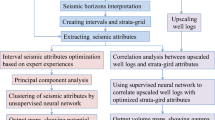Abstract
Precise spatial estimation of ore grades and impurity contents from sample data limited in amount and location is indispensable to metallic and nonmetallic resource exploration. One of the advantages of using geostatistics for this purpose is that it can incorporate multivariate data into spatial estimation of one variable. However, there are two weak points concerning technical and post-processing problems. First is the difficulty in application to geologic data in which spatial correlations are not clear because of intrinsic nonlinear behavior. Second is the absence of indices to interpret the mechanisms and factors which govern the spatial distribution. To address these problems, a spatial method of modeling based on a feedforward neural network, SLANS, which recognizes the relationship between the data value and location by considering supplementary attributes such as lithology and biostratigraphy, and a sensitivity analysis using this network were developed. These methods were applied to two case studies, genetic mechanisms of kuroko deposits and quality assessment of a limestone mine. The first case study is a spatial analysis of principal metals of kuroko deposits (volcanogenic massive sulfide deposits) in the Hokuroku district, northern Japan. It was clarified that upward and downward sensitivity vectors were distinguished near the deposits inside and outside the tectonic basin, respectively. Sensitivity analysis for the second case study showed a strong effect of crystalline limestone on the important impurity, P2O5 contents. Hydrothermal alteration, which could cause leaching and secondary concentration of phosphorus, is considered to have produced this effect.
Similar content being viewed by others
References
Andersson, F. O., berg, M., and Jacobsson, S. P., 2000, Algorithmic approaches for studies of variable influence, contribution and selection in neural networks: Chemometr. Intell. Lab. Syst., v. 51, no.1, p. 61–72.
Crosetto, M., Tarantola, S., and Saltelli, A., 2000, Sensitivity and uncertainty analysis in spatial modeling based on GIS: Agric. Ecosyst. Environ., v. 81, no.1, p. 71–79.
Engelbrecht, A. P., Cloete, I., and Zurada, J. M., 1995, Determining the significance of input parameters using sensitivity analysis, From natural to artificial neural computation: Proceedings of International Workshop on Artificial Neural Networks, Malaga-Torremolinos, Spain, p. 382–388.
Hwang, D., Karimi, H. A., and Byun, D. W., 1998, Uncertainty analysis of environmental models within GIS environments: Comput. Geosci., v. 24, no. 2, p. 119–130.
Jarvis, C. H., and Stuart, N., 1996, The sensitivity of a neural network for classifying remotely sensed imagery: Comput. Geosci., v. 22, no. 9, p. 959–967.
Lenhart, T., Eckhardt, K., Fohrer, N., and Frede, H.-G., 2002, Comparison of two different approaches of sensitivity analysis: Phys. Chem. Earth, v. 27, nos. 9/10, p. 645–654.
Koike, K., Matsuda, S., and Gu, B., 2001, Evaluation of interpolation accuracy of neural kriging with application to temperature-distribution analysis: Math. Geol., v. 33, no. 4, p. 421–448.
Koike, K., Matsuda, S., Suzuki, T., and Ohmi, M., 2002, Neural network-based estimation of principal metal contents in the Hokuroku District, northern Japan, for exploring kuroko-type deposits: Nat. Resour. Res., v. 11, no. 2, p. 135–156.
Koike, K., and Matsuda, S., 2003, Characterizing content distributions of impurities in a limestone mine using a feedforward neural network: Nat. Resour. Res., v. 12, no. 3, p. 209–223.
Li, Y., Brimicombe, A. J., and Ralphs, M. P., 2000, Spatial data quality and sensitivity analysis in GIS and environmental modeling: the case of coastal oil spills: Comput. Environ. Urban Syst., v. 24, no. 2, p. 95–108.
Marseguerra, M., Masini, R., Zio, E., and Cojazzi, G., 2003, Variance decomposition- based analysis via neural networks: Reliab. Eng. Syst. Saf., v. 79, no. 2, p. 229–238.
Matsuda, S., and Koike, K., 2003, Sensitivity analysis of a feedforward neural network for considering genetic mechanisms of kuroko deposits: Nat. Resour. Res., v. 12, no. 4, p. 291–301.
MITI, 1983, Report of regional investigations for 1982 (FY): General investigation for structural analysis: Ministry of International Trade and Industry and Agency of Natural Resources and Energy, Tokyo, Japan, 621 p. (in Japanese).
Newham, L. T. H., Norton, J. P., Prosser, I. P., Croke, B. F. W., and Jakeman, A. J., 2003, Sensitivity analysis for assessing the behaviour of a landscape-based sediment source and transport model: Environ. Modelling Softw., v. 18, nos. 8/9, p. 741–751.
Pastres, R., Chan, K., Solidoro, C., and Dejak, C., 1999, Global sensitivity analysis of a shallow-water 3D eutrophication: Comput. Phys. Commun., v. 117, nos. 1/2, p. 62–74.
Ricotti, M. E., and Zio, E., 1999, Neural network approach to sensitivity and uncertainty analysis: Reliab. Eng. Syst. Saf., v. 64, no. 1, p. 59–71.
Rumelhart, D. E., Hinton, G. E., and Wiliams, R. H., 1986, Learning representations by back-propagating errors: Nature, v. 323, no. 9, p. 533–536.
Sung, A. H., 1998, Ranking importance of input parameters of neural networks: Expert Syst. Appl., v. 15, nos. 3/4, p. 405–411.
Wei, B., Sugiura, N., and Maekawa, T., 2001, Use of artificial neural network in the prediction of algal blooms: Water Res., v. 35, no. 8, p. 2002–2028.
Author information
Authors and Affiliations
Corresponding author
Rights and permissions
About this article
Cite this article
Koike, K., Matsuda, S. New Indices for Characterizing Spatial Models of Ore Deposits by the Use of a Sensitivity Vector and an Influence Factor. Math Geol 38, 541–564 (2006). https://doi.org/10.1007/s11004-006-9030-3
Received:
Accepted:
Published:
Issue Date:
DOI: https://doi.org/10.1007/s11004-006-9030-3




